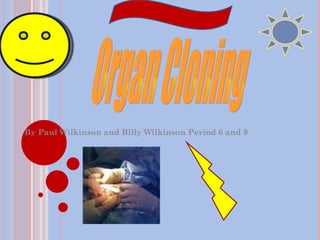
Genetics research
- 1. By Paul Wilkinson and Billy Wilkinson Period 6 and 9 Organ Cloning
- 2. -Alleles are different forms of genes. Dominant alleles and recessive alleles control the inheritance of traits because dominant alleles mask the recessive alleles. -Traits are controlled with co-dominant alleles when there is neither a dominant or recessive allele both alleles will show in the organism. -The alleles of two parents combine to express traits in offspring by passing on either homozygous of heterozygous traits. A pedigree is a diagram representing family relationships of individuals. Basic Principles of Genetics
- 3. Human Genome Project -This project was started officially in October 1990. The main goals of this project was to identify the sequence of every DNA base pair in the human genome. The project was supposed to end in 2005 but ended in 2003. -The legal implications of the human genome project were privacy so no one steals their genetic information and makes a clone and also so insurers and employers will not have access to genetic test results. Another implication is legislation because they have to make laws to make sure nobody tries to steal or use somebody's genetic information. -Some social implications are the fairness and use of genetic information like who should have access to personal genetic information and how would it be used. Also who owns your genetic information? Another implication is how does personal genetic information affect an individual and society‘s of that individual.
- 4. HUMAN GENOME (CONTINUED) -Some ethical implications of the Human Genome Project are reproductive issues such as, do healthcare personnel properly counsel parents about the risks and limitations of genetic technology? Also should testing be performed if no treatment is available? -The human genome project changed current laws such as GINA because they needed to make new laws that protect someone's genetic information.
- 5. GENETIC DISORDER -A gene is a segment of double-stranded DNA that is the unit of heredity in chromosomes. DNA is a large double-stranded, spiraling molecule that contains genetic instructions for growth, development and replication. It is organized into bodies called chromosomes and found in the cell nucleus. A Genetic Disorder is a disease caused by change in part or all of this DNA sequence. -Genetic Disorders can be grouped into three categories Single Gene Disorders, Chromosome abnormalities, and Multifactorial disorders.
- 11. ARGUMENT 1 -There are many different uses for organ cloning besides transplants such as being used to repair injuries from trauma, infections, structural defects, and birth defects. Most recently on March 8, 2011 research scientists at Wake Forest University have reported that they have for the first time successfully created and transplanted a urethra that has worked in five human patients over a period of six years.
- 12. ARGUMENT 2 -Another pro about organ cloning is when you get a donated organ you have to take anti-rejection medications for the rest of your life. Five to ten pills have to be taken daily so your body will not reject the donated organ. Current research at Wake Forest Institute for regenerative medicine are using cells from the human body and growing them into cloned organs that are genetic matches to the cell donor. The cloned organ can be transplanted without a risk of tissue rejection and anti-rejection medication will not be needed.
- 13. ARGUMENT 3 -The third pro about organ cloning is that there will not be a long organ donation list, because people would rather have a cloned organ then waiting for a donated organ. Once you have a shorter organ donation list you wont have to worry of people dieing on the donation list like in the past.
- 14. ARGUMENT 4 -Most recently in the news on March 12, 2011 there was a documented incident of HIV transmission via organ donation. With every organ donation this is a risk of disease transmission to the recipient. This occurs because blood screening tests are not always 100% accurate. If you clone an organ there is no risk of disease transmission because it is made out of the same cells of the recipient.
- 16. WORKS CITED Works Cited Atala, Anthony. "Engineering Organs." Current Opinion in Biotechnology 20 (2009): 575-92. Print. Atala, Anthony. "Tissue Engineering of Human Bladder." British Medical Bulletin 2011, 15 Feb. 2011. Web. 24 Mar. 2011. <http://www.ncbi.nlm.nih.gov/pubmed/21324973>. "Ethical, Legal, and Social Issues --Genome Research." Oak Ridge National Laboratory . Web. 24 Mar. 2011. <http://www.ornl.gov/sci/techresources/Human_Genome/elsi/elsi.shtml>. Furth, Mark E., and Anthony Atala. "Producing Organs in the Laboratory." Current Urology Reports 9.6 (2008): 433-36. Print.